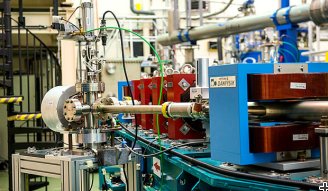Copyright 2012 neutronsources.org | All rights reserved. | Powered by FRM II | Imprint / Privacy Policy
UK’s Daresbury Lab Gears Up for High-Beta Cavity Series Production
Date: 03/05/2017
Source: europeanspallationsource.se
ESS interviews team members at Daresbury Lab in England. The STFC facility is responsible for series production and testing of the 84 high-beta cavities that will form the bulk of the European Spallation Source’s superconducting Accelerator.
At Daresbury Laboratory, located in Cheshire between Manchester and Liverpool, preparations are underway for the fulfilment of a large portion of the UK’s in-kind contribution to the European Spallation Source (ESS): series production and testing of the Accelerator’s high-beta cavities as well as ongoing work for beam transport and diagnostics modules.
The Science & Technology Facilities Council (STFC) is coordinating production of the cavities through Daresbury, where it will perform acceptance testing, including radio frequency (RF) tests in cryogenic conditions. They will also be responsible for ensuring that the cavities are literally spotless before they are locked away inside cryogenic tanks at France’s CEA Saclay laboratory and delivered for installation in Lund.
Much of the work has to be conducted under ISO 4 clean-room conditions at Daresbury to get the best performance out of the cavities when they are put into operation. Daresbury’s Accelerator Science and Technology Centre (ASTeC) also provided ESS with new state-of-the-art vacuum test facilities last year.
“Daresbury Laboratories have a lot of expertise in the field,” says Mike Ellis, Project Manager for Daresbury’s ESS high-beta cavities project. “Even though all effort is made to keep the inside surface clean after manufacturing, you do get some particles naturally in there, that have to be cleaned out before testing and assembling.”
In the videos on the ESS article page you can listen to Mike Ellis describe the testing and cleaning processes; Phil Atkinson, head of Daresbury’s Technology Engineering Group, discuss why the collaboration model works well when building a large-scale infrastructure like ESS; Peter McIntosh, Project Sponsor and Deputy Director for ASTeC, describe the challenges of managing and integrating the large in-kind contribution; and Daresbury’s Head of Technology, John Simpson, give a brief history of Daresbury’s contributions to accelerator technology.
“Many of the technologies that are being implemented for ESS have been demonstrated already, to a certain degree,” says McIntosh,. “I think the scale of the project is the biggest challenge. New ground has to be evaluated and understood and problems solved, and that will be the fundamental challenge.”
